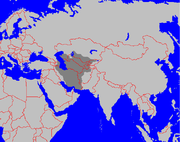Khwarizm
- Khwarizm
-
Khwarezm
Le Khwarezm (Xorazm en ouzbek), également appelé Chorasmie antique, Kharezm, Khorezm, ou encore Khwarizm, est une région historique située au sud de la mer d'Aral, entre les actuels Ouzbékistan, Turkménistan et Iran. On y trouve notamment les villes historiques de Kounya-Ourguentch et de Khiva. Le nom de Khwarezm s'explique par le vieil iranien *Xwāra-zmi-, qui signifie « Pays du soleil ». Les Korasmiens (ou Khorezmiens) furent mentionnés au Ve siècle av. J.-C. par Hérodote.
On connaît une culture, dite de Tazabagyab et apparue vers -1500, d'où les Iraniens du Turkestan occidental ont pu provenir. Elle était située au sud de la mer d'Aral, sur le territoire des futurs Khorezmiens. Elle rassemblait des éléments de la culture des Tombes à Charpente et d'une culture du Kazakhstan, celle d'Andronovo.
Le Khwarezm fut le fief de la dynastie des Khwârazm-Shahs, appelés parfois Khorezmiens entre 1077 et 1231.
Ce fut la région d'origine du mathématicien Muhammad ibn Mūsā al-Khuwārizmī (également orthographié Al-Khawarizmi ou Al-Khorezmi), qui a donné son nom au mot algorithme, et du grand savant Al-Biruni.
Voir aussi
 Portail de l'Ouzbékistan
Portail de l'Ouzbékistan Portail de l’Iran
Portail de l’Iran Portail de l’histoire
Portail de l’histoire
Catégories : Géographie de l'Ouzbékistan | Histoire de l'Ouzbékistan | Histoire du Turkménistan | Histoire de l'Iran | Région historique
Wikimedia Foundation.
2010.
Contenu soumis à la licence CC-BY-SA. Source : Article Khwarizm de Wikipédia en français (auteurs)
Regardez d'autres dictionnaires:
Khwarizm — Choresmien (aus altpersisch: [h]Ūvārasmiy – „gute Erde“; usbekisch und persisch Xorazm, auch Choresm, Chwarizm, Chwarezm) ist eine Landschaft in Zentralasien. Sie liegt am unteren Amudarja (dem antiken Oxus), südlich des Aralsees. Im Mittelalter… … Deutsch Wikipedia
KHAZARS — KHAZARS, a national group of general Turkic type, independent and sovereign in Eastern Europe between the seventh and tenth centuries C.E. During part of this time the leading Khazars professed Judaism. The name is frequently pronounced with an a … Encyclopedia of Judaism
An-Nasir — li Din Allah (1158 ndash; 1225) ( ar. الناصر لدين الله) was the 34th Abbasid Caliph in Baghdad from 1180 to 1225. His pious title means Defender of the Faith . He attempted to restore the Caliphate to its ancient dominant role. He not only held… … Wikipedia
TRANSOXIANA — TRANSOXIANA, ancient region of central Asia, between the Oxus and Jaxartes rivers, known to the Arabs as Ma Waran Nahr ( beyond the river ). In the medieval period it was divided into several provinces, one being Khwarizm, with its two capitals… … Encyclopedia of Judaism
Abū Rayhān Bīrūnī — Infobox Muslim scholars | era = Matthew Deal image caption = Biruni on a 1973 Iranian post stamp commemorating his one thousandth anniversary | name = Abū Rayhān Muhammad ibn Ahmad Bīrunī title= Abu Rayhan Biruni birth = 15 September 973 AD|… … Wikipedia
Kubra — Nadschmuddin Kubra (* 1145 in Chiwa; † 1220 in Choresmien) war ein islamischer Mystiker (siehe Sufismus) und der Gründer der Tariqa Kubrawiyya (Kubrawiyya Derwisch Orden). Sein Name leitet sich wahrscheinlich her von at tammat al kubra (die… … Deutsch Wikipedia
Najmuddin Kubra — Nadschmuddin Kubra (* 1145 in Chiwa; † 1220 in Choresmien) war ein islamischer Mystiker (siehe Sufismus) und der Gründer der Tariqa Kubrawiyya (Kubrawiyya Derwisch Orden). Sein Name leitet sich wahrscheinlich her von at tammat al kubra (die… … Deutsch Wikipedia
Nedschmeddîn Kubrâ — Nadschmuddin Kubra (* 1145 in Chiwa; † 1220 in Choresmien) war ein islamischer Mystiker (siehe Sufismus) und der Gründer der Tariqa Kubrawiyya (Kubrawiyya Derwisch Orden). Sein Name leitet sich wahrscheinlich her von at tammat al kubra (die… … Deutsch Wikipedia
Corasmia — El Imperio corasmio en 1220. El término Corasmia alude tanto a una región como a una serie de Estados centrados en el curso bajo del Amu Daria y su antiguo delta en el mar de Aral, abarcando la parte septentrional del Gran Irán (el actual… … Wikipedia Español
Ahmad ibn Fadlan — Ahmad ibn Fadlān ibn al Abbās ibn Rašīd ibn Hammād ( ar. أحمد بن فضلان بن العباس بن رشيد بن حماد) was a 10th century Arab Muslim writer and traveler who wrote an account of his travels as a member of an embassy of the Abbasid Caliph of Baghdad to … Wikipedia
 Le royaume des Khwârazm-Shahs
Le royaume des Khwârazm-Shahs
